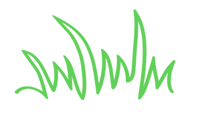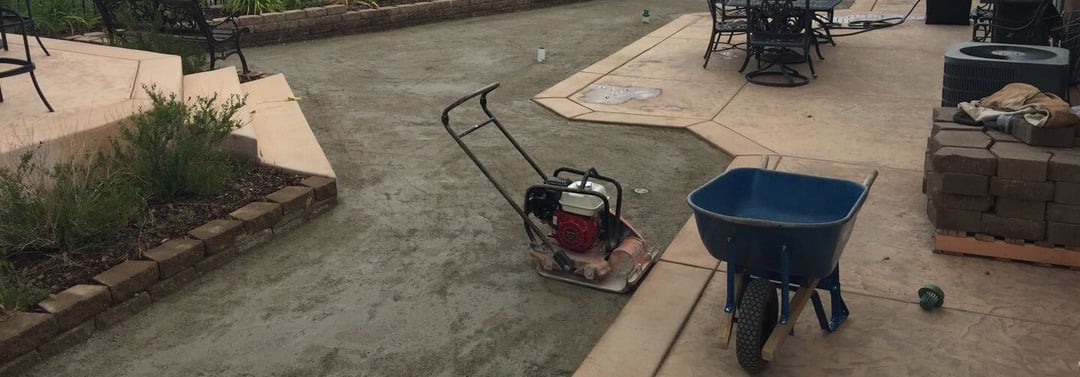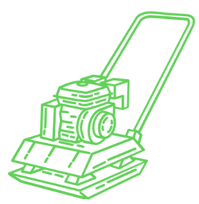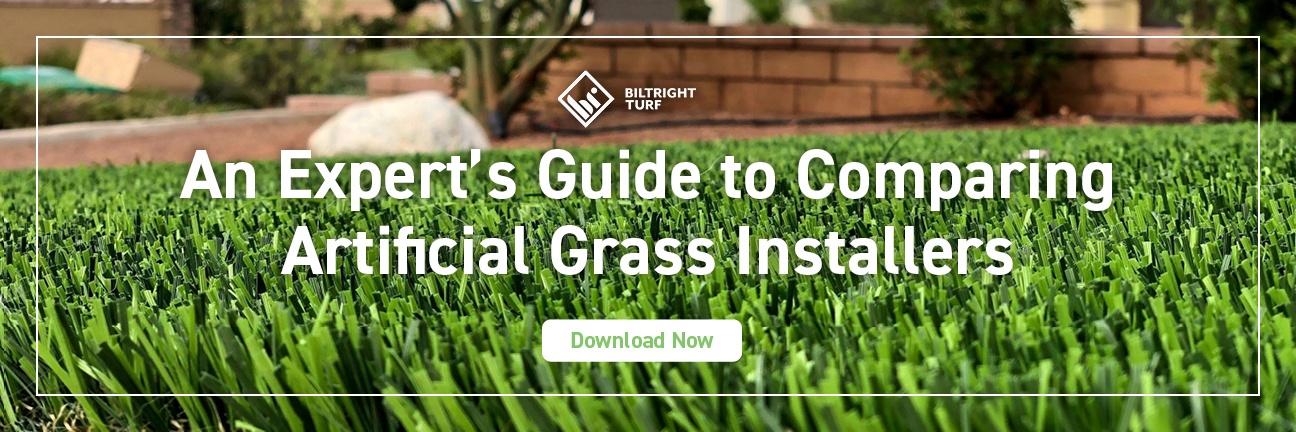The Best Artificial Grass Base for Homeowners
Mar 07, 2023 | Artificial Grass for Homes, Turf Installation

The right base layer makes all the difference when installing artificial grass. A smooth, compact sub-surface can help hold your artificial turf in place, reduce wear, and enable proper water drainage.
Long-lasting artificial turf (with a sturdy base material to match) can be a beautiful part of your landscape for years, enhancing curb appeal and outdoor fun. However, you can't just lay a turf roll down and expect everything to be okay.
In this guide, we'll walk through some steps for synthetic grass installation. Choosing suitable base materials is one of the most critical parts of the process. They make all the difference regarding your synthetic lawn's smoothness, longevity, and curb appeal.
It's All About That Base
 Why does artificial turf need a synthetic grass base — or a sub-base — in the first place?
Why does artificial turf need a synthetic grass base — or a sub-base — in the first place?
Soil contracts and expands with water, making the surface inconsistent. Artificial turf needs a non-expansive, consistent surface that won't introduce wrinkles or wobbly gaps into the surface. A properly prepared base layer is compact, solid, and smooth: the ideal surface for laying down any artificial turf. You don't have to worry about sinking, scuffing, tugging, or other damage from an uneven or unsupported surface.
Can You Just Lay Synthetic Turf Directly on Dirt?
Some people consider simply cutting synthetic turf to match the shape of their lawn and then laying it down straight on top of the soil.
While this might speed up the installation, it significantly shortens the lifespan of your lawn.
Some of the unique drawbacks of installing synthetic turf directly on dirt include:
- Wrinkles: As soil shifts and contracts over time, the turf will no longer perfectly match the underlying surface. This will result in wrinkles and, eventually, tears where there's excess turf.
- Poor drainage: Some soils, like saturated clay soils, don't drain quickly. Instead, the water will pool on top of and underneath the artificial turf. This increases the risk of rot, mildew, and pests.
- Tripping hazard: Loose inches of turf and uncompacted ground under the turf increases the risk of people tripping and falling when they walk or run across the turf. There's not enough structural support.
- Uneven appearance: Turf can't stretch to accommodate soil movement, so it will develop excess wear patterns and a rough surface.
Ultimately, installing turf directly onto the soil will make the artificial turf less beautiful, more susceptible to damage, and more likely to require repairs or replacement sooner.

5 Types of Base Layers for Artificial Lawns
Luckily, homeowners have access to a wide array of time-tested options for base layers. Some are easier to install than others, while some offer superior longevity and structural support. Five well-known sub-bases for artificial grass are:
-
Pea Gravel Base
Pea gravel is composed of small, rounded rocks. While pea gravel is commonly used to build walkways and patios, it's often the wrong fit for sub-base layers. The stones are too round and slippery, allowing for movement. Over time the layer will become less compact, making the surface loose and bumpy.
-
Crushed Miscellaneous Base
This is a popular option for homeowners operating on a budget. Crushed miscellaneous base is a mix of Portland cement concrete and asphalt concrete. It's more affordable than granite while still offering good compaction and long-term reliability. It can even be made from recycled materials for homeowners looking for a sustainable option.
-
Decomposed Granite Base
Decomposed granite is made of small granite rocks. This material creates a smooth underlying surface, compacts very well, and is permeable enough to offer superior drainage over most other popular materials. However, because it's made completely of granite, it can be an expensive option. It also tends to "settle" over the first year as it gets wet, which causes uneven surfaces.
-
Crushed Aggregate Base
This material is different from crushed miscellaneous base. It can be made from different concentrations of crushed rock, asphalt, and concrete. The particles range in size from dust particulate to rocks 3/4" across. This mix of sizes and rough edges helps the material compact into a long-lasting, reliable surface. Homeowners can also choose between finer or larger grades of aggregate material.
-
Class II Road Base
This premium material is a top choice for artificial turf. It's a special mix of small and large aggregate base rated for roads, driveways, patios, and more. The base is permeable, ensuring excellent drainage, and stays compact, even with heavy foot traffic.
So, Which Is the Best Base Material?
Artificial lawns with a Class II road base are built to last through years of use, heavy rainfall, and foot traffic. It's the top choice for homeowners looking for a reliable base material for artificial grass.
However, knowing which material is the right fit for your artificial lawn is insufficient. You also need to know how to install the base layer correctly.
How to Install Class II Road Base
 Installing class II road base involves multiple steps and usually requires specialized equipment. By properly preparing the ground for the base layer, homeowners can ensure they build a new lawn they love.
Installing class II road base involves multiple steps and usually requires specialized equipment. By properly preparing the ground for the base layer, homeowners can ensure they build a new lawn they love.
The Process
DIYers and professional installers alike need to know how to prepare the ground for a well-built base layer. Follow these steps for artificial turf base preparation:
- Remove the existing grass and topsoil. Homeowners can prepare the surface by not watering the lawn, making the grass and topsoil easier to dig up and remove. While many DIYers remove the dirt with a shovel, hired professionals can use compact track loaders. This significantly speeds up the process. Remove at least three inches of topsoil and dirt.
- Grade the underlying dirt to ensure water will drain away from your home. Also, remove sprinklers, so they don't sit under the base layer and turf.
- Lay down the first layer of drain rock. Begin by installing a two-inch layer of larger-grade rock for drainage, and then hose down the surface. Use a hand compactor or vibrating plate compactor to press down the entire surface so the base is tightly compacted.
- Install your second layer of base material. This should be 1-1.5 inches of either Class II road base or decomposed granite. Follow the same steps as with the underlying layer. Ensure the material is very compact and holds the proper grading for the shape of your lawn. It also needs to be smooth and not have any sharp edges.
- Install weed barrier fabric if your lawn is at risk of weeds and you don't have pets.
Once the base layer is installed, you can start on the artificial turf itself. Read our comprehensive Artificial Grass Installer Guide for a step-by-step explanation of the process.
Equipment
 Installing artificial turf and a base layer requires a lot of specialized equipment. You can rent or purchase many of these tools from a local home improvement store:
Installing artificial turf and a base layer requires a lot of specialized equipment. You can rent or purchase many of these tools from a local home improvement store:
Large Equipment
- Carpet kicker
- Compact track loader
- Vibrating plate compactor
- Drop spreader
- Dump trailer
- Power broom
Tools and Materials
- Infill
- Non-galvanized nails
- Putty knives
- Seam Tape
- Weed barrier
Is It Time for a Professional Artificial Turf Installer?
An artificial lawn is an investment in long-term beauty. You could treat the installation as a DIY project, especially if you have advanced DIY skills. However, turning to the experts ensures you have an eye-catching artificial lawn that exceeds your expectations.
The right artificial grass installer will prepare your property and install a top-notch base layer before putting the turf in place. If you're looking for an expert service to handle the job, read our ebook, "An Expert's Guide to Choosing Your Artificial Grass Installer," to find a trustworthy service provider in your area. 

